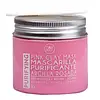What's inside
What's inside
 Key Ingredients
Key Ingredients

 Benefits
Benefits

 Concerns
Concerns

 Ingredients Side-by-side
Ingredients Side-by-side

Water
Skin ConditioningKaolin
AbrasiveBentonite
AbsorbentLaminaria Japonica Extract
Skin ProtectingAloe Barbadensis Leaf Extract
EmollientLactic Acid
BufferingPunica Granatum Fruit Extract
AntioxidantIsododecane
EmollientTocopheryl Acetate
AntioxidantPropylene Glycol
HumectantGlyceryl Stearate
EmollientPEG-100
HumectantMelia Azadirachta Seed Oil
EmollientRosmarinus Officinalis Leaf Extract
AntimicrobialPolysorbate 80
EmulsifyingRetinyl Palmitate
Skin ConditioningXanthan Gum
EmulsifyingAllantoin
Skin ConditioningAcrylates Copolymer
Phenoxyethanol
PreservativeEthylhexylglycerin
Skin ConditioningCI 77491
Cosmetic ColorantWater, Kaolin, Bentonite, Laminaria Japonica Extract, Aloe Barbadensis Leaf Extract, Lactic Acid, Punica Granatum Fruit Extract, Isododecane, Tocopheryl Acetate, Propylene Glycol, Glyceryl Stearate, PEG-100, Melia Azadirachta Seed Oil, Rosmarinus Officinalis Leaf Extract, Polysorbate 80, Retinyl Palmitate, Xanthan Gum, Allantoin, Acrylates Copolymer, Phenoxyethanol, Ethylhexylglycerin, CI 77491
Water
Skin ConditioningCucurbita Pepo
Skin ConditioningAlumina
AbrasiveGlycerin
HumectantTriethanolamine
BufferingCarbomer
Emulsion StabilisingLactobacillus/Pumpkin Fruit Ferment Filtrate
Skin ConditioningSodium Lactate
BufferingAscorbic Acid
AntioxidantTocopheryl Acetate
AntioxidantRetinyl Palmitate
Skin ConditioningBHT
AntioxidantSodium Hyaluronate
HumectantLeuconostoc/Radish Root Ferment Filtrate
AntimicrobialHelianthus Annuus Seed Oil
EmollientCitric Acid
BufferingDisodium EDTA
Benzoic Acid
MaskingSorbic Acid
PreservativePotassium Sorbate
PreservativeSodium Benzoate
MaskingChlorphenesin
AntimicrobialPhenoxyethanol
PreservativeBenzyl Alcohol
PerfumingCinnamal
PerfumingParfum
MaskingWater, Cucurbita Pepo, Alumina, Glycerin, Triethanolamine, Carbomer, Lactobacillus/Pumpkin Fruit Ferment Filtrate, Sodium Lactate, Ascorbic Acid, Tocopheryl Acetate, Retinyl Palmitate, BHT, Sodium Hyaluronate, Leuconostoc/Radish Root Ferment Filtrate, Helianthus Annuus Seed Oil, Citric Acid, Disodium EDTA, Benzoic Acid, Sorbic Acid, Potassium Sorbate, Sodium Benzoate, Chlorphenesin, Phenoxyethanol, Benzyl Alcohol, Cinnamal, Parfum
 Reviews
Reviews

Ingredients Explained
These ingredients are found in both products.
Ingredients higher up in an ingredient list are typically present in a larger amount.
Phenoxyethanol is a preservative that has germicide, antimicrobial, and aromatic properties. Studies show that phenoxyethanol can prevent microbial growth. By itself, it has a scent that is similar to that of a rose.
It's often used in formulations along with Caprylyl Glycol to preserve the shelf life of products.
Retinyl palmitate is a form of retinoid. Retinoids are the superstar class of anti-aging ingredients that include tretinoin and retinol.
This particular ingredient has had a bumpy year with its rise and fall in popularity.
First, Retinyl palmitate is created from palmitic acid and retinol. It is a retinol ester and considered one of the weaker forms of retinoid.
This is because all retinoids have to be converted to Tretinoin, AKA retinoic acid. Retinyl Palmitate is pretty far down the line and has to go through multiple conversions before its effects are seen.
Due to this long and ineffective conversion line, the benefits of Retinyl Palmitate are debated.
Studies show Retinyl Palmitate to help:
Dermatologists say this ingredient is ineffective because it isn't used in high enough concentrations in cosmetics.
This ingredient used to be found in sunscreens to boost the efficacy of sunscreen filters.
The downfall of Retinyl Palmitate was due to released reports about the ingredient being correlated to sun damage and skin tumors.
While there is a study showing this ingredient to cause DNA damage when exposed to UV-A, there is no concrete proof of it being linked to skin cancer. It is safe to use when used correctly.
All retinoids increase your skin's sensitivity to the sun in the first few months of usage. Be especially careful with reapplying sunscreen when using any form of retinoid.
Currently, this ingredient is still allowed in cosmetics all over the world. In Canada, cosmetics must have a warning label stating the product to contain Retinyl Palmitate
Fun fact: This ingredient is often added to low-fat milk to increase the levels of Vitamin A.
Learn more about Retinyl PalmitateTocopheryl Acetate is AKA Vitamin E. It is an antioxidant and protects your skin from free radicals. Free radicals damage the skin by breaking down collagen.
One study found using Tocopheryl Acetate with Vitamin C decreased the number of sunburned cells.
Tocopheryl Acetate is commonly found in both skincare and dietary supplements.
Learn more about Tocopheryl AcetateWater. It's the most common cosmetic ingredient of all. You'll usually see it at the top of ingredient lists, meaning that it makes up the largest part of the product.
So why is it so popular? Water most often acts as a solvent - this means that it helps dissolve other ingredients into the formulation.
You'll also recognize water as that liquid we all need to stay alive. If you see this, drink a glass of water. Stay hydrated!
Learn more about Water